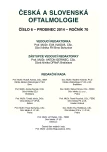Orbital Complications of Sinusitis
Authors:
M. Šuchaň 1; M. Horňák 2; L. Kaliarik 1; S. Krempaská 1; T. Koštialová 1; J. Kovaľ 1
Authors‘ workplace:
Klinika ORL a chirurgie hlavy a krku
LF UPJ· a UNLP, Ko‰ice, prednosta
prof. MUDr. Juraj Kovaº, CSc.
1; Oãná klinika LF UPJ· a UNLP, Ko‰ice
prednosta MUDr. Monika Moravská
2
Published in:
Čes. a slov. Oftal., 70, 2014, No. 6, p. 234-238
Category:
Original Article
Overview
Orbital complications categorised by Chandler are emergency. They need early diagnosis and agresive treatment. Stage and origin of orbital complications are identified by rhinoendoscopy, ophtalmologic examination and CT of orbite and paranasal sinuses. Periorbital cellulitis and early stage of orbital cellulitis can be treated conservatively with i. v. antibiotics. Monitoring of laboratory parameters and ophtalmologic symptoms is mandatory. Lack of improvement or worsening of symptoms within 24–48 hours and advanced stages of orbital complications are indicated for surgery. The purpose of the study is to evaluate epidemiology, clinical features and management of sinogenic orbital complications. Retrospective data of 8 patients with suspicion of orbital complication admited to hospital from 2008 to 2013 were evaluated. Patients were analyzed in terms of gender, age, CT findings, microbiology, clinical features, stage and treatment. Male and female were afected in rate 1,66:1. Most of patients were young adult in 3rd. and 4th. decade of life (62,5 %). Acute and chronic sinusitis were cause of orbital complication in the same rate. The most common origin of orbital complication was ethmoiditis (62,5 %), than maxillary (25 %) and frontal (12,5 %) sinusitis. Polysinusitis with affection of ethmoidal, maxillary and frontal sinuses (75 %) was usual CT finding. Staphylococcus epidermidis and Staphylococcus aureus were etiological agens in half of cases. Periorbital oedema (100 %), proptosis, chemosis (50 %), diplopia and glaucoma (12,5 %) were observed. Based on examinations, diagnosis of periorbital oedema/preseptal cellulitis was made in 3 (37,5 %), orbital cellulitis in 3 (37,5 %) and subperiosteal abscess in 2 cases (25 %). All patients underwent combined therapy – i. v. antibiotics and surgery within 24 hours. Eradication of disease from ostiomeatal complex (OMC), drainage of affected sinuses and drainage of subperiosteal abscess were done via fuctional endonasal endoscopic surgery (FEES). In case of superior subperiosteal abscess, combined endonasal and external approach (external orbitotomy) was needed. Combined therapy facilitated quick improvement of local and systematic symptoms. Average time of hospitalisation was 7 days. Early diagnosis and agresive combined therapy prevent loss of vision and life threatening complications.
Key words:
orbital complications, sinusitis, OMC, FEES
Sources
1. Ben Amor, M., Romdhane, N., Zribi, S. et al.: Orbital complications of sinusitis. J Fr Ophthalmol, 36, 2013, 6: 488–493.
2. Brook, I., Frazier, E., H.: Microbiology of subperiosteal orbital abscess and associated maxillary sinusitis. Laryngoscope. 106, 1996, 8: 1010–1013.
3. Chandler, J., R., Langenbrunner, D., J., Stenvens, E., R.: The pathogenesis of orbital complications in acute sinusitis. Laryngoscope, 80, 1970, 9: 1414–1428.
4. Coenraad, S., Buwalda, J.: Surgical or medical management of subperiosteal orbital abscess in children: a critical appraisal of the literature. Rhinology, 47, 2009, 1: 18–23.
5. Cruz, V., A., A., Demarco, R., C., Valera F., C., P. et al.: Orbital complications of acute rhinosinusitis: a new classification. Rev. Bras. Otorinolaryngol, 73, 2007, 5: 684–688.
6. El-Silimy, O.: The place of endonasal endoscopy in the treatment of orbital cellulitis. Rhinology, 33, 1995, 2: 93–96.
7. Kayhan, F., T., Sayin, I., Yazici, Z., M. et al.: Management of orbital subperiosteal abscess. J Craniofac Surg, 21, 2010, 4: 1114–1117.
8. Ketenci, I., Unlu, Y., Vural, A. et al.: Approaches to subperiosteal orbital abscesses. Eur Arch Otorhinolaryngol, 270, 2013, 4: 1317–1327.
9. Moloney, J., R., Badham, N., J., Mc Rae, A.: The acute orbit. Preseptal ( periorbital ) cellulitis, subperiostal abscess and orbital cellulitis due to sinusitis. J. Laryngol Otol Suppl, 1978, 12: 1–18.
10. Mortimore, S., Wormald, P., J.: The Groote Schuur hospital classification of the orbital complications of sinusitis. J Laryngol Otol, 111, 1997, 8: 719–723.
11. Oxford, L., E., McClay, J.: Medical and surgical management of subperiosteal orbital abscess secondary to acute sinusitis in children. I J Ped Otorhinolarnygol, 70, 2006, 11: 1853–1861.
12. Radovani, P., Vasili, D., Xhelili, M. et al.: Orbital complications of sinusitis. Balkan Med J, 2013, 30: 151–154.
13. Sičák, M. et al: Rinológia – choroby nosa a prínosových dutín. Martin, Kozák – Press, 2006, 339 s.
14. Siedek, V., Kremer, A., Betz, C., S. et al.: Management of orbital complications due to rhinosinusitis. Eur Arch Otorhinolaryngol, 267, 2010, 12: 1881–1886.
15. Stammberger, H.: Complications of inflammatory paranasal sinus diseases including iatrogenic – induced complications. Eur Arch Otolarygol Suppl, 1993, 1: 61–102.
16. Suhaili, D., N., Goh, B., S., Gendeh, B., S.: A ten year retrospective review of orbital complications secondary to acute sinusitis in children. Med J Malaysia, 65, 2010, 1: 49–52.
17. Williams, S., R., Carruth, J. A., S.: Orbital infection secondary to sinusitis in children: diagnosis and management. Clin Otolaryngol, 17,1992, 6: 550–557.
Labels
OphthalmologyArticle was published in
Czech and Slovak Ophthalmology

2014 Issue 6
Most read in this issue
- Orbital Complications of Sinusitis
- Actual State of the One Day Simultaneous Bilateral Cataract Surgery Issue
- Diagnostic Pitfalls of Pseudo-Foster Kennedy Syndrome – A Case Report
- The Molecular Genetic and Clinical Findings in two Probands with Stargardt Disease
